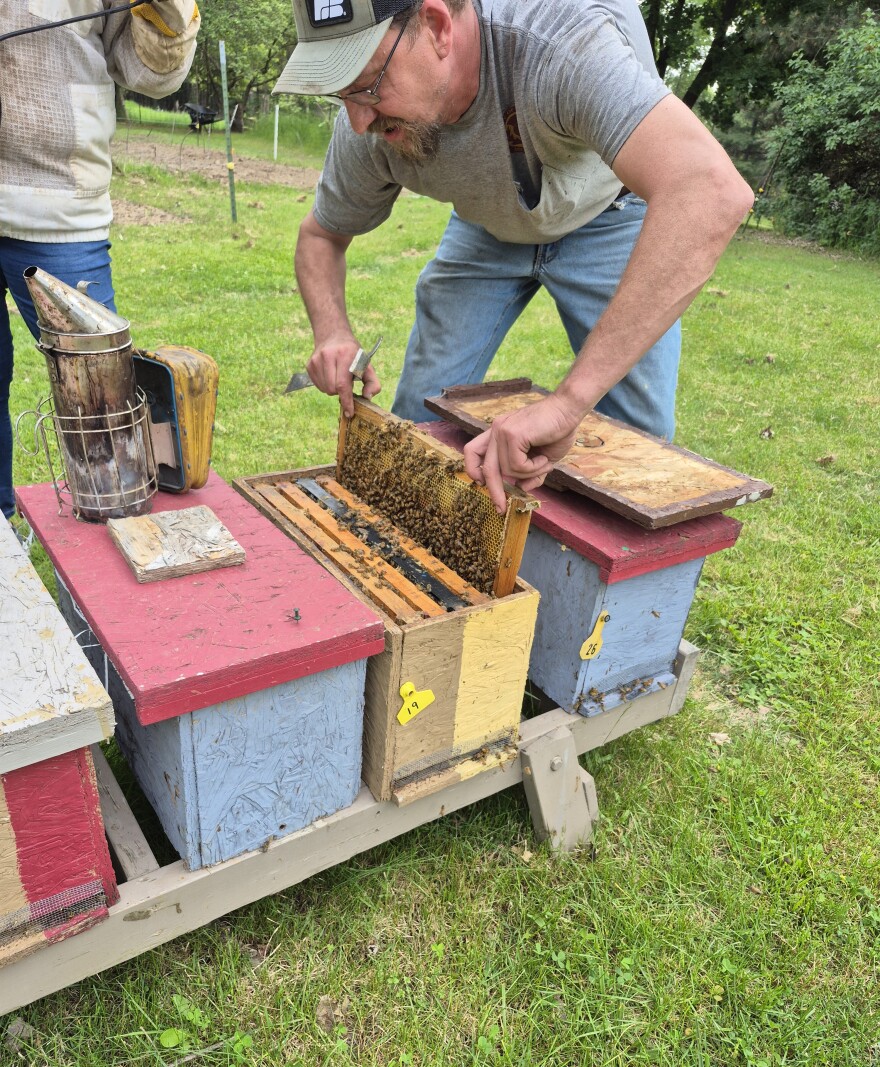Editor's note: This story was produced for the ear and designed to be heard. If you're able, WCMU encourages you to listen to the audio version of this story by clicking the LISTEN button above. This transcript was edited for clarity and length.
David Nicholas: In early 2025, commercial beekeepers around the country discovered a massive shortage in their honeybee colonies. Bee researchers are still investigating to learn what's happening but have some ideas.
To find out more, WCMU's Tina Sawyer talked with Michigan State University's top bee expert, Meghan Milbrath. Milbrath started off the discussion by explaining what these 'losses' mean.
Meghan Milbrath: There's not necessarily a shortage that's happening in the United States because these losses, the beekeepers are making up their numbers by making splits. So there is an economic cost. But right now that's being borne by the beekeepers. So what you do is if you have one. Large colony coming out of winter. You can split it. To two or more smaller colonies, the issue and where the economic costs come in is that smaller colonies don't make a honey crop or they won't be up to grade and see if they have to be a certain size to meet a pollination contract, and so it's not necessarily that we'll be at, you know, this severe shortage, it's that it's much harder and more expensive. To be a beekeeper.

Tina Sawyer: So to get a better understanding of how this has affected beekeepers locally, I visited a hobby beekeeper at KHA Bees and Boers in Mt Pleasant. Karl Geiger and his wife Jen, tend to 15 to 16 hives in their backyard. He says his livestock involves over a million bees. So when I asked Karl why he thought commercial operations were experiencing low numbers, he says no one really knows yet.
Karl Geiger: Researchers still trying to figure it out whether it's colony lost or mites, or what combination of what here in. Again, our biggest thing is mites. We're trying to kill a bug on a bug. Basically is what it comes down to and the pathogens that the mites carry is what's actually killing our bees.
TS: The Varroa mite is a parasite that feeds on developing and adult honey bees.
KG: I stay on top of my mites. I'm not a treatment free guy. I do treat and I try to keep good stock.
TS: How do you treat a bee?
KG: With vapor. There's a couple of different ways you can do it. You can get it in a Paddy or you can use auxiliac acid and you can vaporize it in a gun type deal and you squirt it in there and it fogs the whole thing up.
TS: Carl says these methods help his hobby operation, but for commercial beekeepers it can be costly to keep up treatments for larger hives.
KG: There's very few guys coming up through the commercial ranks right now that. It's kind of scary. We do need them. Our native pollinators are not enough to produce enough food for us.

TS: Even though hobby beekeepers are still drawing interest, commercial bee wranglers may need some help. And that said, I refer back to Meghan Milbrath, who is a bee expert at Michigan State University again. I wondered, with any bee shortages in the future if there were any other alternatives for pollination.
MM: I mean, there are places you can use humans with paintbrushes.
TS: Really?!
MM: (laughs) Yeah. I mean, when you're trying to do breeding programs or or things like that, but. I mean insects mediated pollination or animal mediated pollination. This has been the system for 100 million years. You know, as soon as plants, plants, developing flowers and insects, developing wings happened simultaneously. A long time ago in the United States, we have been moving bees. Honey bees on trucks. To meet crop pollination needs, at least since the 1940s.
TS: Meghan, what can the average Michigan resident do to help then?
MM: The biggest thing is to improve the landscape by planting. Reducing pesticide use is a very big one, so only using it when it's absolutely needed, and so making sure that you are putting plants on the ground that are supportive for bees. And in Michigan, a lot of them are trees, things that will support. You know, not only the honey bees, but the the native bees as well.
To find out more about sustaining healthy honeybee populations, click MSU's Pollinator Initiative.
To learn about beekeeping ,click Mid Michigan Beekeepers Association



